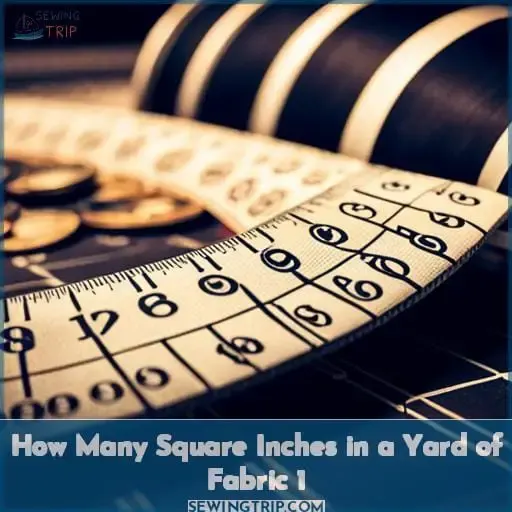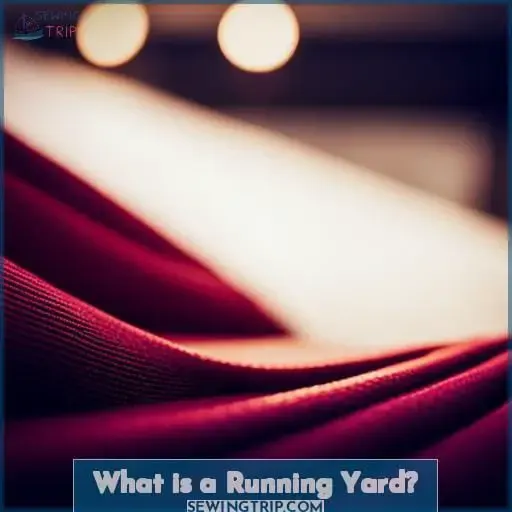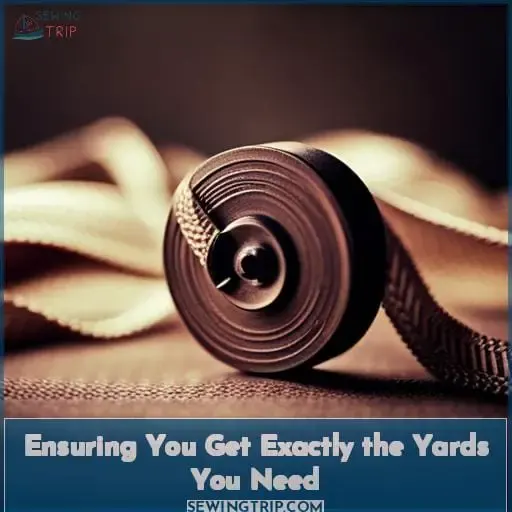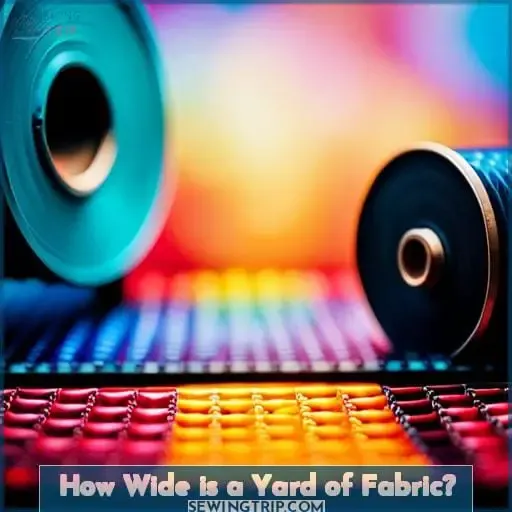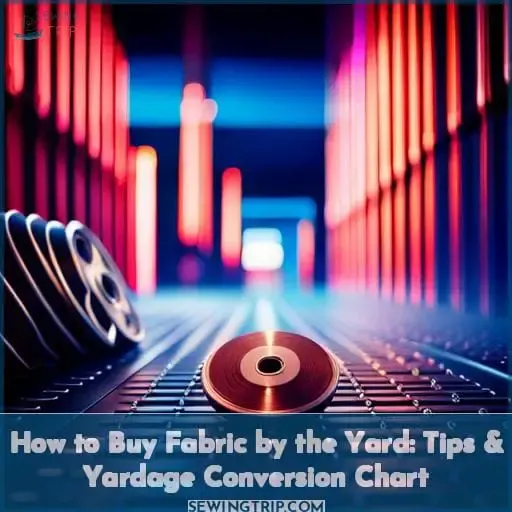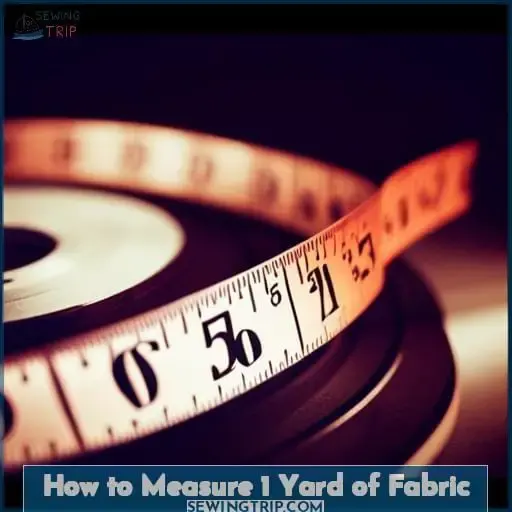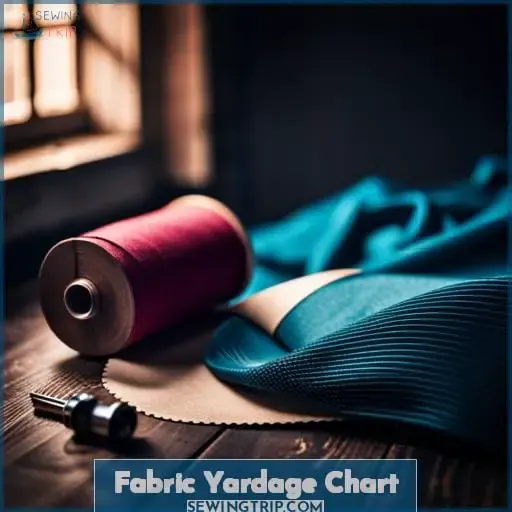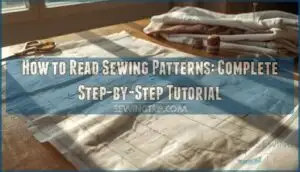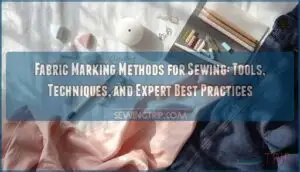This site is supported by our readers. We may earn a commission, at no cost to you, if you purchase through links.

To make sure you get exactly what you need, it’s important to understand different measurements and do some conversions. Wider fabrics can be more economical when purchasing yards or meters of material, while understanding how much one yard will cost can help with budgeting your project.
In this article, we’ll cover everything from running yards through to measuring 1 yard of fabric. We’ll also provide useful charts that convert between units such as inches and centimeters.
Table Of Contents
- Key Takeaways
- How Big is a Yard of Fabric?
- What is a Running Yard?
- Ensuring You Get Exactly the Yards You Need
- How Wide is a Yard of Fabric?
- How is Fabric Sold?
- How to Measure 1 Yard of Fabric
- 1 Yard of Fabric Comparison
- How Much Does a Yard of Fabric Cost?
- Fabric Yardage Chart
- Frequently Asked Questions (FAQs)
- Conclusion
Key Takeaways
- Fabric widths can range from 28 inches to 60 inches or more, affecting the total square inches in a yard of fabric.
- Wider fabrics are generally more cost-effective and can reduce wastage when purchasing yards or meters of material.
- It is important to accurately measure and calculate the amount of fabric needed for a project to avoid running short or wasting excess fabric.
- Using conversion charts or tools can help in converting between units like inches, centimeters, and yards when working with fabric measurements.
How Big is a Yard of Fabric?
You might be surprised to learn that one yard of fabric can contain up to 11,600 individual threads – enough for a whole new wardrobe! When considering how much fabric you need for your project, it’s important to know the width of the fabric and how many yards are needed.
Fabric widths range from 28 inches all the way up to 60 inches or more. It may be more economical in some cases to buy wider fabrics, as this will reduce wastage when cutting out pieces from patterns. It’s also important not only to measure carefully but also to check if any part has been pre-shrunk before buying extra yardage just in case there is an error while cutting out pattern pieces.
Certain types of fabrics require special techniques, such as ripping along a thread or pulling a thread for achieving straight cuts. Embroidered, beaded, and lace materials are usually narrower than other fabrics like cottons used for bedding.
Printable conversion charts available online provide useful information about converting between different units, such as yards, meters, centimeters, and feet. This makes it easier to understand exactly what we mean by 1 square yard, etc. The amount obtained per unit varies greatly depending on the type (silk vs cotton) and width, so it’s always best practice to consider these factors while calculating the cost associated with our projects.
Remnants left over after completing our projects can still find uses at home, either by simply reusing them directly or getting creative with ideas using sewing tutorials found online. These tutorials cover topics ranging from making pajama tops without patterns to even creating headbands, sleep masks, silk pillowcases, DIY mesh bags, and lined zippered pouches.
The necessary tools, such as a tailor ham, are provided, along with complete step-by-step instructions.
With passion and enthusiasm, the author shares knowledge and experiences with readers, showing appreciation through sharing blog posts on social media platforms. The author provides clear information on the About page and answers questions via email.
Contact info is provided for those seeking answers. The liberation powered by mastery is achieved through the crafting endeavors undertaken, and the success enjoyed is the fruit of the labor invested.
What is a Running Yard?
Discover how a running yard of fabric can help you create projects to exact specifications! A running yard is the unit of measure for fabrics, and it’s important to understand this system when buying materials.
It refers to an uncut and continuous length that goes from selvage edge (the self-finished edges on either side) all the way through its width. This method helps prevent wastage due to cutting errors while ensuring accuracy in pattern pieces needed for your project.
Different types of fabrics need different techniques when cutting straight edges. Lace, silk, or heavily embroidered material require special care compared with cotton or other heavier materials like wool blends and upholstery fabric.
Knowing which type you have will also affect the width measurements. Laces are usually narrower than cottons used for bedding, so be sure not only to check if any part has been pre-shrunk before purchasing but also to take into account these variations in dimensions when calculating cost per project.
A comparison between imperial systems used by historical tailors versus today’s metric ones is necessary too. One yard could mean anywhere between 3 feet (36 inches) up to 5 foot 10 1/2 inches depending on where you buy your cloth from, making it difficult at times even with printable conversion charts available online helping convert meters & centimeters into yards & inches.
Ensuring You Get Exactly the Yards You Need
When it comes to fabric, buying wider pieces will often lead to a more economical purchase. To make sure you get the exact number of yards needed for your project, converting between yards and inches or centimeters can be useful.
A yardage conversion chart is a helpful tool when making these calculations. Similarly, meterage charts are available for those needing metric conversions. Knowing how many square inches are in a yard of fabric, as well as understanding that one yard equals 36 inches or 3 feet, makes it easier to convert from one unit of measure to another.
Wider Fabric is Usually More Economical
Widening your fabric search to include wider widths can be more cost-efficient and reduce wastage, giving you a bang for your buck! Buying in bulk is an easy way to get discounts on yardage charts.
Fabric types and widths vary from 28 inches to 60 inches or more. Check selvages before buying as some may not cover the needed body part. A fabric measurements calculator is useful when converting between sizes while taking into account different looms used for measuring systems.
Wide fabrics offer great value compared with narrow ones used for specialized applications like silk, embroidery, and lace.
Making Conversions From Yards to Inches and Centimeters
Unlock the secrets of fabric measurement and save time by quickly converting yards to inches and centimeters! Knowing your fabric widths is essential for buying the right amount. Calculating cost depends on the type, width, and pattern pieces in a sewing project.
Using an imperial tape measure or watching a YouTube video can help. To get square yards of fabric, use a reliable conversion calculator.
Yardage Conversion Chart
Easily keep track of fabric measurements with a yardage conversion chart, so you can confidently buy the right amount for your project. Understand different types of fabrics and their widths to estimate cost accurately.
Convert between running yards, two-yard widths, square yards, and bolt widths in one full tutorial! Know how much material is required before starting any sewing project: from inches to meters or centimeters to feet! Accurate fabric measurement ensures no wastage; get exactly what you need for that perfect creation.
Meterage Conversion Chart
Discover how a meterage conversion chart can help you accurately measure fabric for your project and get the exact amount of material needed. Converting from yards, inches, centimeters, or meters to one convenient metric system of measurement is easy with this chart.
Compare different cuts in order to ensure yardage accuracy and prevent costly wastage when cutting fabrics.
With these measurements on hand, it’s simple to compare various types of fabrics side by side without having to do unnecessary calculations or conversions – saving time while maintaining precision in fabric measurements every time!
Yard of Fabric in Inches: Converting Inches to Yards
Converting inches to yards can be a breeze when you have the right tools. Knowing how much fabric is needed for your project requires knowledge of straight cut techniques, pre-shrunk fabrics, and different looms.
Fabric widths range from 28 to 60, so it’s important to know the actual size of a yard in order to determine how many square inches are in one wide x 1-yard piece. Different types of fabric also vary; silks, embroidery, and lace usually require narrower cuts while cotton bedding may be wider.
With this information at hand, you can easily calculate the exact amount necessary without wasting any material or money on extra fabric remnants!
How Wide is a Yard of Fabric?
When it comes to your sewing project, you’ll need to consider the width of the fabric – ranging from narrow laces and silks up to wider cottons for bedding.
Buying a wider piece of fabric can be economical and reduce wastage, but there are some important things to keep in mind when determining how wide a yard of fabric is:
- Straight cuts: It’s important that you check for straightness before cutting as some fabrics may be cut slightly skew. There are different methods available such as ripping along the thread or pulling a thread depending on what type of material it is.
- Pre-shrinking: Before beginning any project, make sure that if necessary, pre-shrink your chosen material by washing or steam pressing first – this will help avoid any shrinkage after completion which could render your finished product too small!
- Fabric looms & measurement systems: Different looms used in weaving materials mean that not all yards are equal sizes; this should also always be taken into account when calculating cost based on their size per square inch/centimeter, etc.
- Remnant fabrics & other uses: Don’t forget about remnant pieces either – even though they’re usually narrower than standard-sized ones (e.g. silks, heavily embroidered materials, etc.), these still have many uses such as quilting patchwork squares together with others like them, creating beautiful accessories like headbands out of scrap cloth remnants, plus an array of other possible projects.
How is Fabric Sold?
Fabric is typically sold by the running yard, meaning that it’s a continuous length of fabric rather than individual pieces.
- Pre-shrinking: Before cutting any fabric, make sure to pre-shrink it if necessary by washing or steam pressing – this will help avoid shrinkage when finished!
- Fabric widths: When calculating cost per square inch/centimeter, etc., consider different looms and measurement systems as these can affect the width of fabrics purchased – not all yards are equal sizes! Lace fabric or interfacing may be narrower while cotton for bedding can be wider; some specific measurements come in fractions of a yard too.
- Straight cuts: While purchasing from a store, ask the sales attendant to cut straight so that no extra inch is wasted due to skew cuts – certain fabrics require specialized techniques such as ripping along threads or pulling them out before cutting properly!
- Extra inches: It’s recommended to buy an extra inch more than what is specified on patterns just in case mistakes happen while cutting; fabric stores usually give 1-2 inches over the true measurable size when requested which helps with errors too – but remember double-check against the pattern’s measurements for accuracy each time!
- Cost calculation: The amount obtained from one yard depends on its type & width, so always consider both factors before making purchase decisions; compare prices between multiple vendors if needed, and don’t forget about remnants either – they still have many uses even though their sizes might differ slightly compared with regular-sized ones (e.
Sewing projects require careful consideration regarding how much material should be bought based on calculations taking into account various factors like types & widths available, budget restrictions plus additional allowances made around potential mistakes during the actual construction process itself.
How to Measure 1 Yard of Fabric
To ensure you get the correct amount of fabric for your project, measure out one yard with precision and accuracy using a measuring tape or ruler.
The width of the fabric should also be taken into consideration when calculating cost per square inch/centimeter, etc. Not all yards are equal sizes, so comparing different looms and measurement systems can give an idea of how wide fabrics available in stores are.
Lace fabrics and interfacing may be narrower, while cotton for bedding can usually be wider.
It’s recommended to buy an extra inch more than what is specified on patterns just in case mistakes happen while cutting. Good quality tapes, such as Chinese tapes, have tiny nicks at every quarter yard, making them very handy tools! Fabric stores usually provide 1-2 inches over their true measurable size, which helps account for errors during the construction process.
Lastly, compare prices between multiple vendors to obtain better value, along with considering the type and width required before making a buying decision. These factors will affect the amount obtained from one yard differently depending on its own characteristics like density and weight.
A few tips to keep in mind: ask a sales attendant for straight cuts, use special techniques like ripping threads or pulling out for certain types of materials, calculate the cost beforehand including allowances made regarding potential mistakes during the construction process itself, and use good quality tapes marked with tiny nicks at every quarter pounder as they prove very useful tools throughout the entire sewing journey!
Don’t forget about remnants either – they still have many uses even though their sizes might differ slightly compared to regular-sized ones (e.g., silk). So look around carefully online or offline shops today to find the perfect piece that fits your project specifications and budget restrictions accurately without compromising style aesthetics.
The desired end result can be achieved no matter your individual skill level, experience, background, or history working in the textiles industry. Overall satisfaction is guaranteed provided strict adherence to the guidelines outlined above given the circumstances encountered in the particular task or situation at hand.
1 Yard of Fabric Comparison
Compare the different cuts of fabric you’ve purchased to see how much yardage each offers – it could save you from making costly mistakes!
A comparison between cuts of one yard will show variations in size, giving a better understanding of what is needed for any project. Fabric widths can range from 28 inches to 60 inches or more and should be taken into account when calculating the cost per square inch/centimeter, etc.
It’s important to buy an exact number of yards required for your project, though some patterns may specify buying smaller quantities than a true yard; this allows greater area coverage while using fewer pieces and can help offset costs if buying expensive material such as silk or lace.
Pre-shrinking fabric before cutting is also recommended, along with adding extra inches in case there are errors during construction – stores often provide 1-2 extra just in case! Fractions like half or quarter yards are useful too when looking at specific measurements related tutorials on YouTube demonstrate various techniques that work well depending on the type of materials used (e.
Finally, take all factors into consideration before purchasing: quality vs quantity ratio needs to match up well against budget restrictions; double-check pattern requirements against actual measurements achieved from store shelves; consider pre-shrunk options plus allowances made regarding potential cutting errors down the line in later stages of the production process itself.
How Much Does a Yard of Fabric Cost?
Now that you’ve compared different cuts of fabric, it’s time to consider cost. A yard of fabric can vary greatly in price depending on quality, type, and where it is purchased.
Fabric stores may offer discounts for buying wider fabrics or selling ¼ yard pieces, so be sure to compare prices before making a purchase.
It’s important to ensure that you get the right quantity of fabric needed for your project. If necessary, buy a little extra material in case cutting errors occur during construction.
To save money when shopping at US Fabric Store, try:
- Buy wider fabrics: Wider fabrics are usually more economical and reduce waste. They often come pre-shrunk, so there is less worry about shrinkage after washing them later on down the line.
- Consider smaller fractions: If patterns specify an exact measurement that does not add up to exactly one whole yard (e.g., 3 yards + 1 ½ feet), then consider purchasing small fractions like 1/4 or 1/2 yards instead.
- Check pattern requirements vs actual measurements achieved from store shelves: This helps avoid surprises regarding widths that might be unsuitable due to the selvages already present along one side.
- Look out for sales & promotions: Many retailers provide discounted rates based upon certain criteria such as bulk purchases or sale items over specific periods throughout their calendar year(s).
It pays off to do some research beforehand because all these factors will affect how much material is actually obtained within each true ‘yard’ versus what was initially anticipated by visual inspection alone.
The comparison between multiple cuts should now show any variances while allowing us all to gauge better what exactly we need before committing ourselves financially speaking.
And once armed with sufficient knowledge plus budget considerations made accordingly, then we’ll know confidently enough whether our DIY sewing projects are going ahead unhindered by financial constraints whatsoever!
Fabric Yardage Chart
You can easily calculate the exact amount of fabric you need for your project by using a printable Fabric Yardage Chart! This chart helps you convert between different units of measurement, such as meters and centimeters to yards and inches.
It is particularly useful when determining how much fabric to buy for sewing projects or other creative endeavors.
The yardage chart also provides buying tips that will help with cost savings when shopping at US Fabric Store. Wider fabrics are usually more economical than narrower ones, so consider purchasing wider options if possible – this may even come pre-shrunk which eliminates worries about shrinkage after washing later on down the line! Additionally, smaller fractions like 1/4 or 1/2 yards can be purchased instead if patterns specify an exact measurement that does not add up to one whole yard (e.
Further discounts may apply depending on certain criteria such as bulk purchases or sale items during certain periods throughout their calendar year(s).
| Unit | Yards | Inches | Centimeters |
|---|---|---|---|
Frequently Asked Questions (FAQs)
How many square inches are in a yard of fabric?
A yard of fabric contains approximately 3,960 square inches. This impressive amount of material can be used for a wide range of projects, including clothing and home decor items.
How can I be sure that I’m getting the exact number of yards I need?
Ensure you obtain the precise yardage of fabric required for your project by carefully measuring and verifying widths, inspecting for straightness prior to cutting, taking into account the fabric type when calculating the cost, and purchasing a small additional amount to account for any potential errors.
What are the different methods for cutting a straight edge?
You can ensure a straight cut by ripping along the grain of your fabric, pulling a thread, or taking extra care with embroidered and lace fabrics. Ensure you measure accurately to get the correct amount of yards for your project.
How do I convert between yards, inches, and centimeters?
Convert between yards, inches, and centimeters easily with printable yardage conversion charts. Discover the exact number of yards needed for your project and calculate costs accordingly.
How much extra fabric should I buy to account for cutting mistakes?
It is recommended to buy a little extra fabric in case of mistakes while cutting. Calculate the width of pattern pieces and add 1-2 inches more than the exact yardage specified for best results. Check if the fabric has been pre-shrunk or wash it before starting your project.
Conclusion
In conclusion, fabric is an essential part of any sewing project. It can make or break the success of the garment. Knowing the measurement of a yard of fabric, the width of the fabric, and the cost of the fabric is essential to ensuring your project is a success.
With the right knowledge and tools, you can create beautiful garments and projects that will last for years to come.

